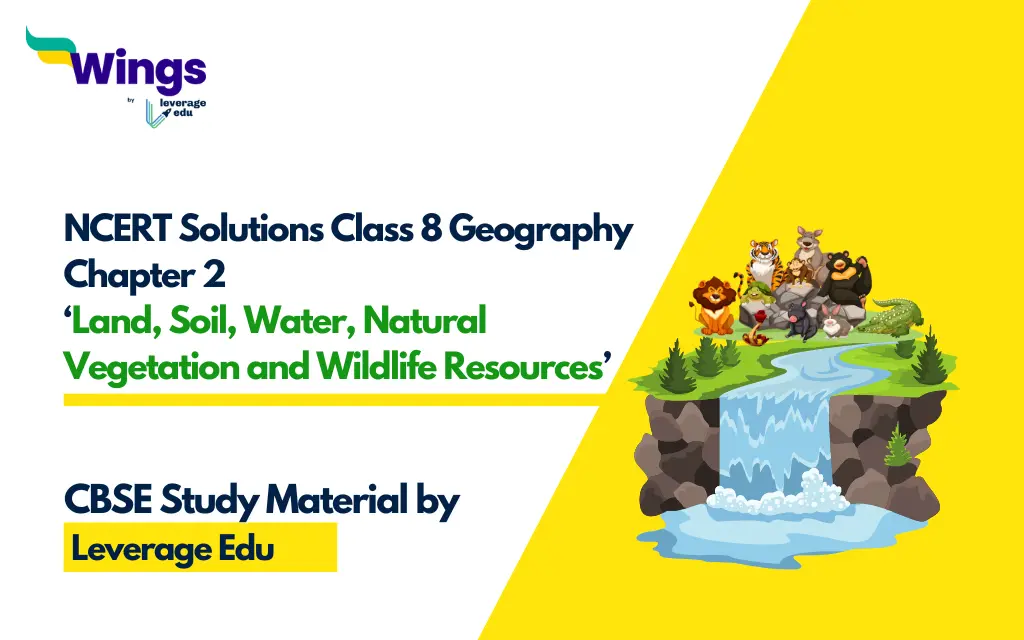We are providing NCERT Solutions Class 8 Geography Chapter 2 ‘Land, Soil, Water, Natural Vegetation and Wildlife Resources’. A PDF of these solutions is also available for download. These will help you in preparing for your school exams. You can refer to these and ace your exams! Let us get started!
Download the NCERT Solutions Class 8 Geography Chapter 2 PDF Here!
Explore Solutions of all the Chapters of Class 8 Geography:
NCERT Solutions Class 8 Geography Chapter 2 ‘Land, Soil, Water, Natural Vegetation and Wildlife Resources’
Here are NCERT Solutions of Class 8 Geography Chapter 2 ‘Land, Soil, Water, Natural Vegetation and Wildlife Resources’ to the questions in the exercise section of the lesson.
1. Answer the following questions.
(i) Which are the two main climatic factors responsible for soil formation?
Answer: Two main climatic factors responsible for soil formation include rainfall and temperature. In these, the rainfall influences the rate of humus formation and weathering.
(ii) Write any two reasons for land degradation today.
Answer: the rate of degradation of land is of concern today. The two reasons for land degradation are deforestation and overgrazing by cattle.
(iii) Why is land considered an important resource?
Answer: Land is one of the most important natural resources because it covers almost 30% area of the total Earth’s surface and can be used in many ways such as agriculture, forestry, etc.
(iv) Name any two steps that the government has taken to conserve plants and animals.
Answer: Two major steps taken by the government to protect and conserve plants, animals and natural vegetation are:
- National parks, wildlife sanctuaries, and biosphere reserves are made to protect our natural vegetation and wildlife.
- Awareness programmes like social forestry and Vanamohatasava are being encouraged at the regional and community level.
(v) Suggest three ways to conserve water.
Answer: Three main ways to conserve water are:
a. Aforestation that is Increasing forest cover and other vegetation to slow the surface runoff.
b. Using rainwater harvesting to replenish groundwater.
c. Using less water-intensive methods in agriculture.
2. Tick the correct answer.
(i) Which one of the following is NOT a factor of soil formation?
(a) Time
(b) Soil texture
(c) Organic matter
Answer: b. Soil Texture
(ii) Which one of the following methods is most appropriate to check soil erosion on steep slopes?
(a) Shelterbelts
(b) Mulching
(c) Terrace cultivation
Answer: c) Terrace cultivation
(iii) Which one of the following is NOT in favour of the conservation of nature?
(a) switch off the bulb when not in use
(b) close the tap immediately after using
(c) dispose poly packs after shopping
Answer: c) Dispose poly packs after shopping
3. Match the following.
| Column A | Column B |
| Land use | prevent soil erosion |
| Humus | narrow zone of contact between the lithosphere, hydrosphere and atmosphere |
| Rock Dams | productive use of land |
| Biosphere | organic matter deposited on top soil |
| Contour ploughing |
Answer:
| Column A | Column B |
| Land use | productive use of land |
| Humus | organic matter deposited on top soil |
| Rock Dams | prevent soil erosion |
| Biosphere | narrow zone of contact between the lithosphere, hydrosphere and atmosphere |
4: State whether the given statement is true or false. If true, give the reasons.
(i). Ganga–Brahmaputra plain of India is an overpopulated region.
Answer: True.
(ii) Water availability per person in India is declining.
Answer: True
(iii) Rows of trees planted in the coastal areas to check the wind movement are called intercropping.
Answer: False
(iv). Human interference and changes of climate can maintain the ecosystem.
Answer: False
Download the NCERT Solutions Class 8 Geography Chapter 2 PDF Here!
Explore Solutions of all the Chapters of Class 8 Geography:
Related Reads:
Explore Notes of All subjects of CBSE Class 8:
| CBSE Notes Class 8 English | CBSE Notes Class 8 History | CBSE Notes Class 8 Geography |
| CBSE Notes Class 8 Civics | CBSE Notes Class 8 Mathematics | CBSE Notes Class 8 Science |
FAQs
Ans: The name of SST Geography Class 8 Chapter 2 is “Land, Soil, Water, Natural Vegetation and Wildlife Resources”.
Ans: Land is one of the most important natural resources and covers almost 30% area of the total Earth’s surface.
Ans: Wildlife includes animals, birds, insects as well as aquatic life forms. Animals big or small, all are integral to maintaining balance in the ecosystem.
Follow Leverage Edu for complete study material on CBSE Notes of Class 8 Geography.
 One app for all your study abroad needs
One app for all your study abroad needs














